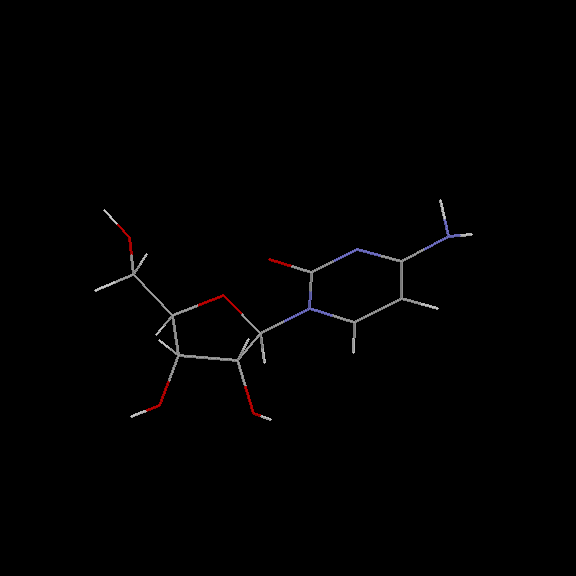Cytidine Elisa Kit
Cytidine is a molecule belonging to the nucleoside family, formed when a molecule of cytosine and a cyclic ribose molecule (ribofuranose) are attached via a β-N1-glycosidic bond. If the cytosine molecule is attached to a deoxyribose (where carbon 2 loses its -OH alcohol function), it forms a deoxycytidine.
Accession Number : KLM0000097 This work is released into the public domain; please see our release statement.
Doug Markham has contributed a molecular mechanics computation of the structure! See below for the details.

Config Rule :
% cytidine
config(cytidine,[
substituent(cytosinyl),
substituent('D-1-dehydroxy-ribofuranosyl'),
linkage(from('D-1-dehydroxy-ribofuranosyl',car(1)),
to(cytosinyl,nit(1)),
up,single)]).
config('D-1-dehydroxy-ribofuranosyl',[
ring([
oxy,
anomeric(1,hyd),
car(2,hyd&&hydroxyl;),
car(3,hyd&&hydroxyl;),
car(4,hydroxymethyl&&hyd;)])]).
config(cytosinyl,[
ring([
nit(1)&,
car(2,oxy?)&,
nit(3)&,
car(4,amine(7))&,
car(5,hyd)&,
car(6,hyd)&])]).
Smiles String :
[C@2H]-1([O][C@2H]([C@2H]([OH])[C@2H]-1[OH])[C@2H2][OH])-[n]1([c]([n][c]([cH][c_
H]1)[NH2])[O-])
cytidine
Terminal :
% cytidine
c(1,12,(0,chiral))-[c(2,left)~,o(1,right)~,n(1,up)~,h(1,down)~],
c(2,12,(0,chiral))-[c(3,left)~,c(1,right)~,h(2,up)~,o(2,down)~],
c(3,12,(0,chiral))-[c(4,left)~,c(2,right)~,h(4,up)~,o(3,down)~],
c(4,12,(0,chiral))-[o(1,left)~,c(3,right)~,c(5,up)~,h(6,down)~],
c(5,12,(0,nonchiral))-[h(7,left)~,h(8,right)~,o(4,up)~,c(4,down)~],
c(6,12,(0,nonchiral))-[o(5,nil)?,n(1,flat)&,n(3,flat)&],
c(8,12,(0,nonchiral))-[n(7,nil)~,n(3,flat)&,c(9,flat)&],
c(9,12,(0,nonchiral))-[h(12,nil)~,c(8,flat)&,c(10,flat)&],
c(10,12,(0,nonchiral))-[h(13,nil)~,c(9,flat)&,n(1,flat)&],
h(1,1,(0,nonchiral))-[c(1,up)~],
h(2,1,(0,nonchiral))-[c(2,down)~],
h(3,1,(0,nonchiral))-[o(2,nil)~],
h(4,1,(0,nonchiral))-[c(3,down)~],
h(5,1,(0,nonchiral))-[o(3,nil)~],
h(6,1,(0,nonchiral))-[c(4,up)~],
h(7,1,(0,nonchiral))-[c(5,right)~],
h(8,1,(0,nonchiral))-[c(5,left)~],
h(9,1,(0,nonchiral))-[o(4,nil)~],
h(10,1,(0,nonchiral))-[n(7,nil)~],
h(11,1,(0,nonchiral))-[n(7,nil)~],
h(12,1,(0,nonchiral))-[c(9,nil)~],
h(13,1,(0,nonchiral))-[c(10,nil)~],
n(1,14,(0,nonchiral))-[c(1,down)~,c(6,flat)&,c(10,flat)&],
n(3,14,(0,nonchiral))-[c(8,flat)&,c(6,flat)&],
n(7,14,(0,nonchiral))-[h(10,nil)~,h(11,nil)~,c(8,nil)~],
o(1,16,(0,nonchiral))-[c(1,left)~,c(4,right)~],
o(2,16,(0,nonchiral))-[h(3,nil)~,c(2,up)~],
o(3,16,(0,nonchiral))-[h(5,nil)~,c(3,up)~],
o(4,16,(0,nonchiral))-[h(9,nil)~,c(5,down)~],
o(5,16,(0,nonchiral))-[c(6,nil)?]
The Terminals for all the Config Rules are in Prolog Definite Clause Grammar (DCG) form.They can be checked in the Manual here.
The compound's PDB file can be seen here.
Doug Markham of the Institute for Cancer Research, Fox Chase Cancer Center,Philadelphia, PA, has contributed the following structure for cytidine. He computed this structure in sdf format using MacroModel, a molecular mechanics program. We have used Babel to convert the .sdf format to PDB format. You'll find it interesting to compare these structures to those computed using CONCORD.
Many thanks Doug!
